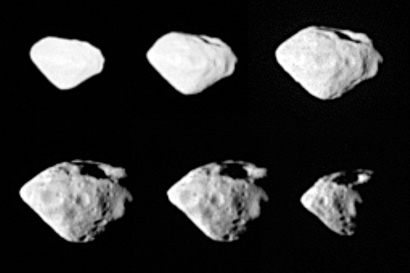First Rosetta/OSIRIS images of asteroid Steins
6 September 2008
Images of asteroid Steins, taken by the OSIRIS Wide Angle Camera during the fly-by, were presented at a press conference on 6 September.
| Preliminary results (from OSIRIS)* | |
| Size | 5.9 x 4 km (equivalent effective diameter of 5 km) |
| Shape | diamond shaped |
| Albedo | 0.35 ± 0.05 |
| Craters | Dominated by a large crater on the north with diameter of ~ 2 km; a second large crater lies in the shadowed region; a chain of 7 craters is seen; a total of 23 craters have been counted with diameter greater than 200 m |
| For OSIRIS there is a remarkable agreement between the pre-fly-by predictions and the actual observations. | |
|
First impression is that this asteroid has had a complex collision history. | |
| * as reported at the press conference on 6 September. See also the link to "Asteroid (2867) Steins -first results" on the right-hand menu | |
| Preliminary results (from GIADA)* | |
| GIADA confirms a clean environment (i.e. no detection of very small particles) around Steins | |
|
GIADA worked well; first results look good; housekeeping data was as expected; the team consider this to be good news for the comet encounter later. | |
| * as reported at the press conference on 6 September 2008 |
Last Update: 1 September 2019




